Note: This question is part of a series of questions that present the same scenario. Each question in the series contains a unique solution that might meet the stated goals. Some question sets might have more than one correct solution, while others might not have a correct solution.
After you answer a question in this section, you will NOT be able to return to it. As a result, these questions will not appear in the review screen.
Your company has deployed several virtual machines (VMs) on-premises and to Azure. Azure ExpressRoute has been deployed and configured for on-premises to Azure connectivity.
Several VMs are exhibiting network connectivity issues.
You need to analyze the network traffic to determine whether packets are being allowed or denied to the VMs.
Solution: Use the Azure Traffic Analytics solution in Azure Log Analytics to analyze the network traffic.
Does the solution meet the goal?
Answer:
B
Instead use Azure Network Watcher to run IP flow verify to analyze the network traffic.
Reference:
https://docs.microsoft.com/en-us/azure/network-watcher/network-watcher-monitoring-overview https://docs.microsoft.com/en-us/azure/network-watcher/network-watcher-ip-flow-verify-overview
HOTSPOT -
You manage a database environment for a Microsoft Volume Licensing customer named Contoso, Ltd. Contoso uses License Mobility through Software
Assurance.
You need to deploy 50 databases. The solution must meet the following requirements:
✑ Support automatic scaling.
✑ Minimize Microsoft SQL Server licensing costs.
What should you include in the solution? To answer, select the appropriate options in the answer area.
NOTE: Each correct selection is worth one point.
Hot Area: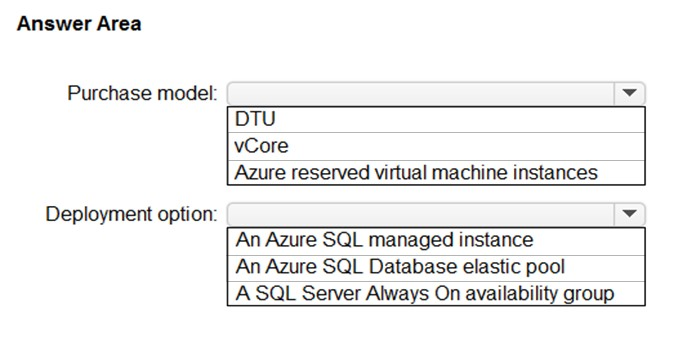
Answer:
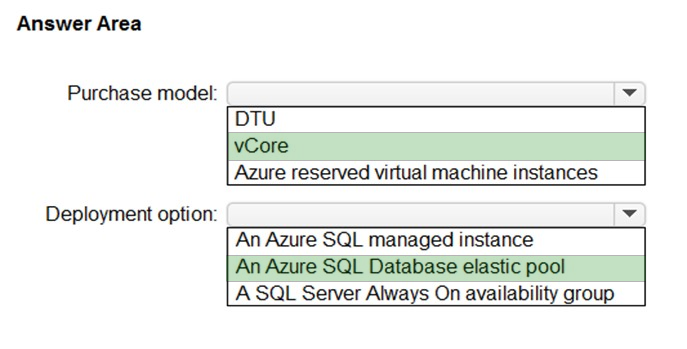
Box 1: vCore -
Virtual core (vCore)-based purchasing model (recommended). This purchasing model provides a choice between a provisioned compute tier and a serverless compute tier. With the provisioned compute tier, you choose the exact amount of compute resources that are always provisioned for your workload. With the serverless compute tier, you specify the autoscaling of the compute resources over a configurable compute range
Box 2: An Azure SQL Database Elastic pool
Azure SQL Database provides the following deployment options for a database:
✑ Single database represents a fully managed, isolated database.
✑ Elastic pool is a collection of single databases with a shared set of resources, such as CPU or memory. Single databases can be moved into and out of an elastic pool.
Reference:
https://docs.microsoft.com/en-us/azure/azure-sql/database/purchasing-models
DRAG DROP -
You plan to import data from your on-premises environment into Azure. The data is shown in the following table.
What should you recommend using to migrate the data? To answer, drag the appropriate tools to the correct data sources. Each tool may be used once, more than once, or not at all. You may need to drag the split bar between panes or scroll to view content.
NOTE: Each correct selection is worth one point.
Select and Place:
Answer:

Reference:
https://docs.microsoft.com/en-us/azure/dms/tutorial-sql-server-to-azure-sql https://docs.microsoft.com/en-us/azure/cosmos-db/import-data
You have an Azure virtual machine named VM1 that runs Windows Server 2019 and contains 500 GB of data files.
You are designing a solution that will use Azure Data Factory to transform the data files, and then load the files to Azure Data Lake Storage.
What should you deploy on VM1 to support the design?
Answer:
D
The integration runtime (IR) is the compute infrastructure that Azure Data Factory uses to provide data-integration capabilities across different network environments. For details about IR, see Integration runtime overview.
A self-hosted integration runtime can run copy activities between a cloud data store and a data store in a private network. It also can dispatch transform activities against compute resources in an on-premises network or an Azure virtual network. The installation of a self-hosted integration runtime needs an on-premises machine or a virtual machine inside a private network.
Reference:
https://docs.microsoft.com/en-us/azure/data-factory/create-self-hosted-integration-runtime
HOTSPOT -
Your company is designing a multi-tenant application that will use elastic pools and Azure SQL databases. The application will be used by 30 customers.
You need to design a storage solution for the application. The solution must meet the following requirements:
✑ Operational costs must be minimized.
✑ All customers must have their own database.
✑ The customer databases will be in one of the following three Azure regions: East US, North Europe, or South Africa North.
What is the minimum number of elastic pools and Azure SQL Database servers required? To answer, select the appropriate options in the answer area.
NOTE: Each correct selection is worth one point.
Hot Area: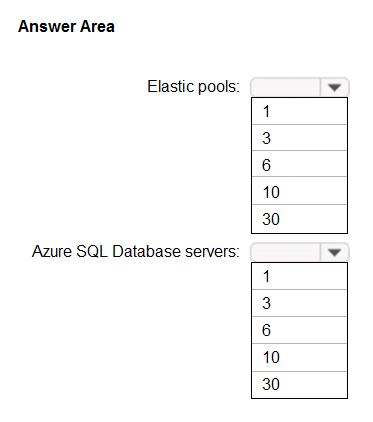
Answer:
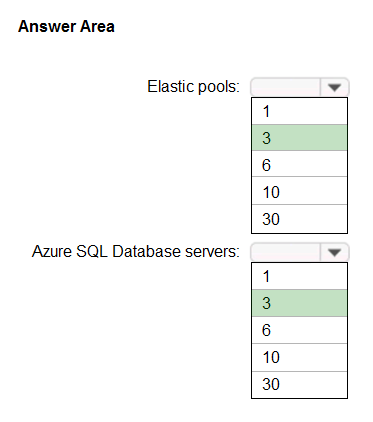
Box 1: 3 -
The server, its pools & databases must be in the same Azure region under the same subscription.
Box 2: 3 -
A server can have up to 5000 databases associated to it.
Reference:
https://vincentlauzon.com/2016/12/18/azure-sql-elastic-pool-overview/
You are reviewing an Azure architecture as shown in the Architecture exhibit. (Click the Architecture tab.)
The estimated monthly costs for the architecture are shown in the Costs exhibit. (Click the Costs tab.)
The log files are generated by user activity to Apache web servers. The log files are in a consistent format. Approximately 1 GB of logs are generated per day.
Microsoft Power BI is used to display weekly reports of the user activity.
You need to recommend a solution to minimize costs while maintaining the functionality of the architecture.
What should you recommend?
Answer:
C
AzCopy is a command-line utility that you can use to copy blobs or files to or from a storage account.
Cron is one of the most useful utility that you can find in any Unix-like operating system. It is used to schedule commands at a specific time. These scheduled commands or tasks are known as "Cron Jobs".
Reference:
https://docs.microsoft.com/en-us/azure/storage/common/storage-use-azcopy-configure
You deploy Azure App Service Web Apps that connect to on-premises Microsoft SQL Server instances by using Azure ExpressRoute. You plan to migrate the
SQL Server instances to Azure.
Migration of the SQL Server instances to Azure must:
✑ Support automatic patching and version updates to SQL Server.
✑ Provide automatic backup services.
✑ Allow for high-availability of the instances.
✑ Provide a native VNET with private IP addressing.
✑ Encrypt all data in transit.
✑ Be in a single-tenant environment with dedicated underlying infrastructure (compute, storage).
You need to migrate the SQL Server instances to Azure.
Which Azure service should you use?
Answer:
D
Azure SQL Database Managed Instance configured for Hybrid workloads. Use this topology if your Azure SQL Database Managed Instance is connected to your on-premises network. This approach provides the most simplified network routing and yields maximum data throughput during the migration.
Reference:
https://docs.microsoft.com/en-us/azure/dms/resource-network-topologies
You plan to store data in Azure Blob storage for many years. The stored data will be accessed rarely.
You need to ensure that the data in Blob storage is always available for immediate access. The solution must minimize storage costs.
Which storage tier should you use?
Answer:
A
Data in the cool access tier can tolerate slightly lower availability, but still requires high durability, retrieval latency, and throughput characteristics similar to hot data. For cool data, a slightly lower availability service-level agreement (SLA) and higher access costs compared to hot data are acceptable trade-offs for lower storage costs.
Incorrect Answers:
B: Archive storage stores data offline and offers the lowest storage costs but also the highest data rehydrate and access costs.
Archive - Optimized for storing data that is rarely accessed and stored for at least 180 days with flexible latency requirements (on the order of hours).
Reference:
https://docs.microsoft.com/en-us/azure/storage/blobs/storage-blob-storage-tiers
DRAG DROP -
You are designing a virtual machine that will run Microsoft SQL Server and will contain two data disks. The first data disk will store log files, and the second data disk will store data. Both disks are P40 managed disks.
You need to recommend a caching policy for each disk. The policy must provide the best overall performance for the virtual machine while preserving integrity of the SQL data and logs.
Which caching policy should you recommend for each disk? To answer, drag the appropriate policies to the correct disks. Each policy may be used once, more than once, or not at all. You may need to drag the split bar between panes or scroll to view content.
Select and Place: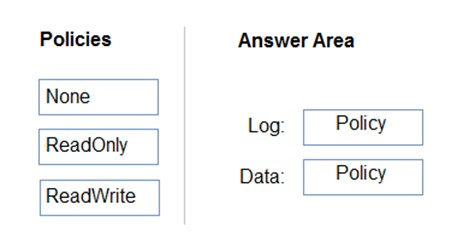
Answer:
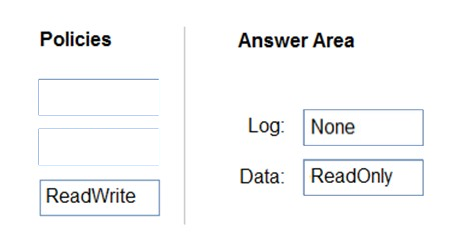
Reference:
https://docs.microsoft.com/en-us/azure/virtual-machines/windows/sql/virtual-machines-windows-sql-performance
You are designing a SQL database solution. The solution will include 20 databases that will be 20 GB each and have varying usage patterns.
You need to recommend a database platform to host the databases. The solution must meet the following requirements:
✑ The compute resources allocated to the databases must scale dynamically.
✑ The solution must meet an SLA of 99.99% uptime.
✑ The solution must have reserved capacity.
✑ Compute charges must be minimized.
What should you include in the recommendation?
Answer:
D
Azure SQL Database elastic pools are a simple, cost-effective solution for managing and scaling multiple databases that have varying and unpredictable usage demands. The databases in an elastic pool are on a single server and share a set number of resources at a set price. Elastic pools in Azure SQL Database enable
SaaS developers to optimize the price performance for a group of databases within a prescribed budget while delivering performance elasticity for each database.
Guaranteed 99.995 percent uptime for SQL Database
Reference:
https://docs.microsoft.com/en-us/azure/azure-sql/database/elastic-pool-overview https://azure.microsoft.com/en-us/pricing/details/sql-database/elastic/